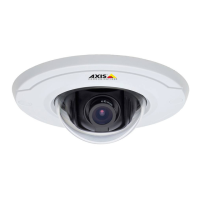48
AXIS M3014 - Glossary of Terms
uniquely identifies it from all others, and each data packet
contains both the sender's address and the receiver's address.
The Internet Protocol ensures that th
e data packets all arrive at
the intended address. As IP is a connectionless protocol, which
means that there is no established connection between the
communication end-points, packets can be sent via different
routes and do not need to arrive at the destination in the
correct order.
Once the data packets have arrived at
the correct destination,
another protocol - Transmission Control Protocol (TCP) - puts
them in the right order. See also TCP.
IP Address - An IP address is simply an addres
s on an IP
network used by a computer/device connected to that network.
IP addresses allow all the connected computers/devices to find
each other and to pass data back and forth.
To avoid conflicts, each IP address
on any given network must
be unique. An IP address can be assigned as fixed, so that it
does not change, or it can be assigned dynamically (and
automatically) by DHCP.
An IP address consists of four groups (or quads) of decimal
digit
s separated by periods, e.g. 130.5.5.25. Different parts of
the address represent different things. Some part will represent
the network number or address, and some other part will
represent the local machine address.
See also IP (Internet Protocol).
I-VOP - See VOP.
JPEG (Joint Photographic Experts Group) - Together with
the
GIF file format, JPEG is an image file type commonly used
on the web. A JPEG image is a bitmap, and usually has the file
suffix '.jpg' or ".jpeg." When creating a JPEG image, it is
possible to configure the level of compression to use. As the
lowest compression (i.e. the highest quality) results in the
largest file, there is a trade-off between image quality and file
size.
kbit/s (kilobits per second) - A measure of the bit rate, i.e. the
rate
at which bits are passing a given point. See also Bit rate.
LAN (Local Area Network) - A LAN is a group of computers
an
d associated devices that typically share common resources
within a limited geographical area.
Linux - Linux is an open source operat
ing system within the
UNIX family. Because of its robustness and availability, Linux
has won popularity in the open source community and among
commercial application developers.
MAC address (Media Access Control address) - A MAC
address
is a unique identifier associated with a piece of
networking equipment, or more specifically, its interface with
the network. For example, the network card in a computer has
its own MAC address.
Manual iris - This is the opposite to an autoiris, i.e. the camera
iris
must be adjusted manually to regulate the amount of light
allowed to reach the image sensor.
Mbit/s (Megabits per second) - A measure of the bit rate, i.e.
the rat
e at which bits are passing a given point. Commonly
used to give the ‘speed’ of a network. A LAN might run at 10 or
100 Mbit/s. See also Bit rate.
Monitor - A monitor is very similar to a standard television set,
bu
t lacks the electronics to pick up regular television signals.
Motion JPEG - Motion JPEG is a simple
compressi
on/decompression technique for networked video.
Latency is low and image quality is guaranteed, regardless of
movement or complexity of the image. Image quality is
controlled by adjusting the compression level, which in turn
provides control over the file size, and thereby the bit rate.
High-quality individual images from
the Motion JPEG stream
are easily extracted. See also JPEG.
Megapixel - See Pixel.
Multicast - Bandwidth-conserving technology that
reduces
bandwidth usage by simultaneously delivering a single stream
of information to multiple network recipients.
Network connectivity - The physical (wired or wireless) and
logical
(protocol) connection of a computer network or an
individual device to a network, such as the Internet or a LAN.
NTSC (National Television Syst
em Committee) - NTSC is the
television and video standard in the United States. NTSC
delivers 525 lines at 60 half-frames/second.
NWay - A network protocol that auto
matically negotiates the
highest possible common transmission speed between two
devices.
PAL (Phase Alternating Line) - PAL is the dominant television
st
andard in Europe. PAL delivers 625 lines at 50
half-frames/second.
Ping - Ping is a basic network program used diagnostically to
ch
eck the status of a network host or device. Ping can be used
to see if a particular network address (IP address or host name)
is occupied or not, or if the host at that address is responding
normally. Ping can be run from e.g. the Windows Command
prompt or the command line in UNIX.
Pixel - A pixel is one of the many tiny dots that make up a
digit
al image. The color and intensity of each pixel represents a
tiny area of the complete image.
PoE (Power over Ethernet) - Power over Ethernet provides
powe
r to a network device via the same cable as used for the
network connection. This is very useful for IP-Surveillance and
remote monitoring applications in places where it may be too
impractical or expensive to power the device from a power
outlet.
PPP (Point-to-Point Protocol) - A protocol that uses a serial
interface
for communication between two network devices. For
example, a PC connected by a phone line to a server.
PPTP (Point-to-Point Tunneling Protocol) - A protocol (set
of communication
rules) that allows corporations to extend
their own corporate network through private "tunnels" over the
public Internet. In this way a corporation can effectively use a
WAN (Wide Area Network) as a large single LAN (Local Area
Network). This kind of interconnection is known as a virtual
private network (VPN).
Pre/post alarm images - The images from immediately before
and
after an alarm. These images are stored in a buffer for later

